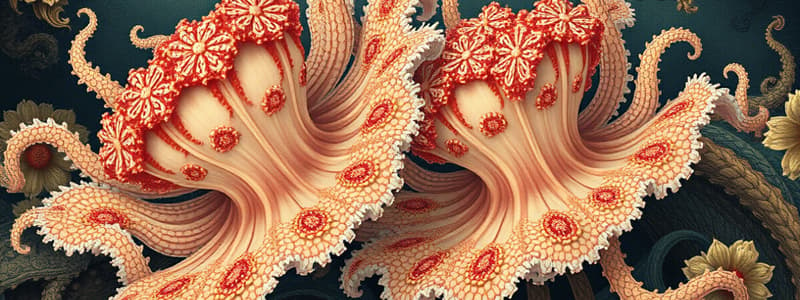Podcast
Questions and Answers
What is the primary method of reproduction for sponges?
What is the primary method of reproduction for sponges?
- Asexual reproduction only through fission
- Sexual reproduction through gametes
- Asexual reproduction by budding and fragmentation (correct)
- Budding exclusively
Which type of body symmetry do most sponges exhibit?
Which type of body symmetry do most sponges exhibit?
- Radial symmetry or asymmetry (correct)
- Bilateral symmetry only
- No symmetry at all
- Spherical symmetry
What is the function of choanocytes in sponges?
What is the function of choanocytes in sponges?
- Regenerate lost body parts
- Drive water through the body (correct)
- Absorb nutrients from the water
- Participate in sexual reproduction
What type of skeleton do sponges have?
What type of skeleton do sponges have?
How do sponges carry out gas exchange and waste removal?
How do sponges carry out gas exchange and waste removal?
Flashcards are hidden until you start studying
Study Notes
General Characteristics of Sponges
- Primitive multicellular organisms lacking tissue and organ formation.
- Predominantly marine species, with some freshwater varieties.
- Sedentary lifestyle leveraging filter-feeding mechanisms for nutrition.
- Body structure may exhibit radial symmetry or be asymmetrical.
- Central cavity, known as spongocoel or atrium, opens externally through an osculum.
- Numerous pores termed ostia facilitate water flow into the sponge's body.
- Possess a single layer of choanocytes (flagellated cells) that drive water circulation.
- Lack specialized systems for circulation, respiration, digestion, and excretion; rely on a water system to perform these functions.
- Asexual reproduction occurs through processes like budding and fragmentation.
- Nutrition obtained through holozoic feeding, which involves engulfing food particles.
- Exhibit neurosensory cells, enabling basic responsiveness to environmental changes.
- Capable of regeneration, allowing recovery of lost body parts.
- Gas exchange and elimination of nitrogenous wastes occur via diffusion across cell membranes.
- Skeleton structure comprised of spongin fibers and calcareous spicules for support and protection.
Studying That Suits You
Use AI to generate personalized quizzes and flashcards to suit your learning preferences.




